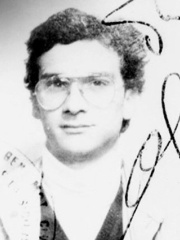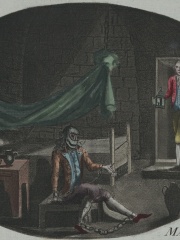
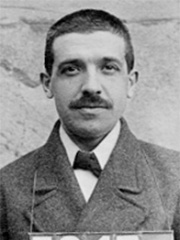

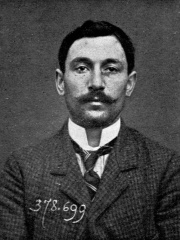
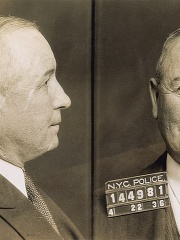

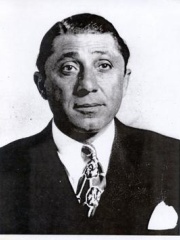
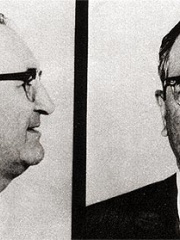
The Most Famous
EXTREMISTS from Italy
This page contains a list of the greatest Italian Extremists. The pantheon dataset contains 209 Extremists, 11 of which were born in Italy. This makes Italy the birth place of the 4th most number of Extremists behind United Kingdom and Germany.
Top 10
The following people are considered by Pantheon to be the top 10 most legendary Italian Extremists of all time. This list of famous Italian Extremists is sorted by HPI (Historical Popularity Index), a metric that aggregates information on a biography’s online popularity. Visit the rankings page to view the entire list of Italian Extremists.

1. Man in the Iron Mask (1640 - 1703)
With an HPI of 72.71, Man in the Iron Mask is the most famous Italian Extremist. His biography has been translated into 34 different languages on wikipedia.
The Man in the Iron Mask (French: L'Homme au Masque de Fer; died 19 November 1703) was an unidentified prisoner of state during the reign of King Louis XIV of France (1643–1715). Warranted for arrest on 28 July 1669 under the pseudonym of "Eustache Dauger", he was incarcerated on 24 August and held for 34 years in the custody of the same jailer, Bénigne Dauvergne de Saint-Mars, in four successive French prisons, including the Bastille. When he died there on 19 November 1703, his inhumation certificate bore the pseudonym of "Marchioly", leading several 19th century historians to conclude the prisoner was Italian diplomat Ercole Antonio Mattioli. His true identity remains a mystery, even though it has been extensively debated by historians, and various theories have been expounded in numerous books, articles, poems, plays, and films. Among the oldest theories is one proposed by the French philosopher and writer Voltaire, who claimed in the second edition of his Questions sur l'Encyclopédie (1771) that the prisoner was an older, illegitimate brother of Louis XIV. This assertion of a royal connection was echoed later by authors who proposed variants of this aristocratic solution. What little is known about the prisoner is based on contemporary documents that surfaced during the 19th century, mainly some of the correspondence between Saint-Mars and his superiors, in which the prisoner had been labelled "only a valet" shortly after his arrest. What emerges from these documents is that he was jailed for "what he had seen", "what he knew", and "what he was employed to do" before his arrest. Legend has it that no one ever saw his face, as it was hidden by a mask of black velvet cloth, later misreported by Voltaire as an iron mask. Official documents reveal, however, that the prisoner was made to cover his face only when travelling between prisons after 1687, or when going to prayers within the Bastille in the final years of his incarceration; modern historians believe the latter measure was imposed by Saint-Mars solely to increase his own prestige at the end of his career, thus causing persistent rumours to circulate about this seemingly important prisoner. In 1932, French historian Maurice Duvivier proposed that the prisoner was Eustache Dauger de Cavoye, a nobleman associated with several political scandals of the late 17th century. This solution, however, was disproved in 1953 when previously unpublished family letters were discovered by another French historian, Georges Mongrédien, who concluded that the enigma remained unsolved owing to the lack of reliable historical documents about the prisoner's identity and the cause of his long incarceration. The Man in the Iron Mask has been the subject of many works of fiction, most prominently in 1850 by Alexandre Dumas. A section of his novel The Vicomte of Bragelonne: Ten Years Later—the final installment of his D'Artagnan saga—features this prisoner, portrayed as Louis XIV's identical twin and forced to wear an iron mask. In 1840, Dumas had first presented a review of the popular theories about the prisoner extant in his time in the chapter "L'homme au masque de fer", published in the eighth volume of his non-fiction Crimes Célèbres. This approach was adopted by many subsequent authors, and speculative works have continued to appear on the subject.

2. Charles Ponzi (1882 - 1949)
With an HPI of 67.35, Charles Ponzi is the 2nd most famous Italian Extremist. His biography has been translated into 32 different languages.
Charles Ponzi (, Italian: [ˈpontsi]; born Carlo Pietro Giovanni Guglielmo Tebaldo Ponzi; March 3, 1882 – January 18, 1949) was an Italian swindler and con artist who operated in the U.S. and Canada. His aliases included Charles Ponci, Carlo, and Charles P. Bianchi. Born in Lugo, Italy, he became known in the early 1920s as a swindler in North America for his money-making scheme. He promised clients a 50% profit within 45 days or 100% profit within 90 days, by buying discounted postal reply coupons in other countries and redeeming them at face value in the U.S. as a form of arbitrage.: 1 In reality, Ponzi was paying earlier investors using the investments of later investors. While this type of fraudulent investment scheme was not invented by Ponzi, it became so identified with him that it now is referred to as a "Ponzi scheme". His scheme ran for over a year before it collapsed, costing his "investors" $20 million. Ponzi may have been inspired by the scheme of William W. Miller (also known as "520% Miller"), a Brooklyn book-keeper who in 1899 used a similar deception to take in $1 million (approximately $35 million in 2022).

3. Tommaso Buscetta (1928 - 2000)
With an HPI of 63.47, Tommaso Buscetta is the 3rd most famous Italian Extremist. His biography has been translated into 23 different languages.
Tommaso Buscetta (Italian pronunciation: [tomˈmaːzo buʃˈʃetta]; 13 July 1928 – 2 April 2000) was a high ranking Italian mobster and a member of the Sicilian Mafia. He became one of the first of its members to turn informant and explain the inner workings of the organization. Buscetta participated in criminal activity in Italy, the United States and Brazil before being arrested and extradited from Brazil to Italy. He became disillusioned with the Mafia after the murders of several of his family members, and in 1984, decided to cooperate with the authorities. He provided important testimony at the 1986/87 Maxi Trial, the largest anti-Mafia trial in history. After the murder of the judges Giovanni Falcone and Paolo Borsellino, Buscetta gave further testimony to the Antimafia Commission linking Italian politicians to the Mafia. Buscetta entered the Witness Protection Program in the United States, where he remained until his death in 2000.

4. Vincenzo Peruggia (1881 - 1925)
With an HPI of 63.16, Vincenzo Peruggia is the 4th most famous Italian Extremist. His biography has been translated into 24 different languages.
Vincenzo Peruggia (8 October 1881 – 8 October 1925) was an Italian museum worker, artist and thief, most famous for stealing the Mona Lisa from the Louvre Museum in Paris on 21 August 1911.
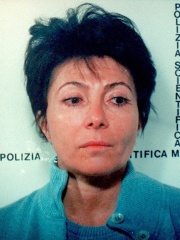
5. Patrizia Reggiani (1948 - )
With an HPI of 61.64, Patrizia Reggiani is the 5th most famous Italian Extremist. Her biography has been translated into 18 different languages.
Patrizia Reggiani (Italian: [paˈtrittsja redˈdʒaːni]; née Martinelli; born 2 December 1948) is an Italian convicted criminal and former socialite. She was convicted in a highly publicized trial of hiring a hitman to kill her ex-husband, Maurizio Gucci.

6. Johnny Torrio (1882 - 1957)
With an HPI of 60.78, Johnny Torrio is the 6th most famous Italian Extremist. His biography has been translated into 22 different languages.
John Donato Torrio (born Donato Torrio, Italian: [doˈnaːto ˈtɔrrjo]; January 20, 1882 – April 16, 1957) was an Italian-born American mobster who helped build the Chicago Outfit in the 1920s later inherited by his protégé Al Capone. Torrio proposed a National Crime Syndicate in the 1930s and later became an adviser to Lucky Luciano and his Luciano crime family. Torrio had several nicknames, primarily "The Fox" for his cunning and finesse. The US Treasury official Elmer Irey considered him "the biggest gangster in America" and wrote, "He was the smartest and, I dare say, the best of all the hoodlums. 'Best' referring to talent, not morals". Virgil W. Peterson of the Chicago Crime Commission stated that his "talents as an organizational genius were widely respected by the major gang bosses in the New York City area". Crime journalist Herbert Asbury affirmed: "As an organizer and administrator of underworld affairs, Johnny Torrio is unsurpassed in the annals of American crime; he was probably the nearest thing to a real mastermind that this country has yet produced".

7. Carlo Gambino (1902 - 1976)
With an HPI of 58.98, Carlo Gambino is the 7th most famous Italian Extremist. His biography has been translated into 23 different languages.
Carlo Gambino (Italian: [ˈkarlo ɡamˈbiːno]; August 24, 1902 – October 15, 1976) was a Sicilian-born American crime boss who was the leader and namesake of the Gambino crime family of New York City. Following the Apalachin Meeting in 1957, and the imprisonment of Vito Genovese in 1959, Gambino took over the Commission of the American Mafia and played a powerful role in organized crime until his death from a heart attack in 1976. During a criminal career that spanned over fifty years, Gambino served only twenty-two months in prison for a tax evasion charge in 1937.

8. Frank Nitti (1886 - 1943)
With an HPI of 57.54, Frank Nitti is the 8th most famous Italian Extremist. His biography has been translated into 18 different languages.
Frank Ralph Nitto (born Francesco Raffaele Nitto, Italian: [franˈtʃesko raffaˈɛːle ˈnitto]; January 27, 1886 – March 19, 1943), known as Frank Nitti, was an Italian-American organized crime figure based in Chicago. The first cousin and bodyguard of Al Capone, Nitti was in charge of all money flowing through the operation. Nitti later succeeded Capone as acting boss of the Chicago Outfit.

9. Joseph Bonanno (1905 - 2002)
With an HPI of 55.08, Joseph Bonanno is the 9th most famous Italian Extremist. His biography has been translated into 18 different languages.
Joseph Charles Bonanno (born Giuseppe Carlo Bonanno; Italian: [dʒuˈzɛppe ˈkarlo boˈnanno]; January 18, 1905 – May 11, 2002), sometimes referred to as Joe Bananas, was an Italian-American crime boss of the Bonanno crime family, which he ran from 1931 to 1968. Bonanno was born in Castellammare del Golfo, Sicily, where his father was also involved in organized crime. At the age of three, Bonanno immigrated to New York City with his family, where he lived for about 10 years before he moved back to Italy. He later slipped back into the United States in 1924, by stowing away on a Cuban fishing boat bound for Tampa, Florida. After the Castellammarese War, Salvatore Maranzano was murdered in 1931, Bonanno reorganized most of the crime family as the Bonanno family. At age 26, Bonanno became one of the youngest-ever bosses of a crime family. In 1963, Bonanno made plans with Joseph Magliocco to assassinate several rivals on the Mafia Commission. When Magliocco gave the contract to one of his top hit men, Joseph Colombo, he revealed the plot to its targets. The Commission spared Magliocco's life but forced him into retirement, while Bonanno fled to Canada. In 1964, he briefly returned to New York before disappearing until 1966. The "Banana War" ensued and lasted until 1968, when Bonanno retired to Arizona. Later in life, he became a writer, publishing the book A Man of Honor: The Autobiography of Joseph Bonanno in 1983. Bonanno died on May 11, 2002, in Tucson, Arizona.
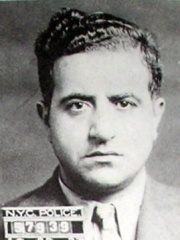
10. Albert Anastasia (1902 - 1957)
With an HPI of 54.52, Albert Anastasia is the 10th most famous Italian Extremist. His biography has been translated into 18 different languages.
Umberto "Albert" Anastasia (, Italian: [umˈbɛrto anastaˈziːa]; né Anastasio [anaˈstaːzjo]; September 26, 1902 – October 25, 1957) was an Italian-American mobster, hitman and crime boss. One of the founders of the modern American Mafia, and a co-founder and later boss of the Murder, Inc. organization, he eventually rose to the position of boss in what became the modern Gambino crime family. He also controlled New York City's waterfront for most of his criminal career, mainly through the dockworker unions. Anastasia was murdered on October 25, 1957, on the orders of Vito Genovese and Carlo Gambino; Gambino subsequently became boss of the family. Anastasia was one of the most ruthless and feared organized crime figures in American history; his reputation earned him the nicknames The Earthquake, The One-Man Army, Mad Hatter and Lord High Executioner.
Pantheon has 11 people classified as extremists born between 1640 and 1962. Of these 11, 1 (9.09%) of them are still alive today. The most famous living extremists include Patrizia Reggiani. The most famous deceased extremists include Man in the Iron Mask, Charles Ponzi, and Tommaso Buscetta. As of April 2022, 1 new extremists have been added to Pantheon including Patrizia Reggiani.
Living Extremists
Go to all RankingsDeceased Extremists
Go to all Rankings
Man in the Iron Mask
1640 - 1703
HPI: 72.71
Charles Ponzi
1882 - 1949
HPI: 67.35
Tommaso Buscetta
1928 - 2000
HPI: 63.47
Vincenzo Peruggia
1881 - 1925
HPI: 63.16
Johnny Torrio
1882 - 1957
HPI: 60.78
Carlo Gambino
1902 - 1976
HPI: 58.98
Frank Nitti
1886 - 1943
HPI: 57.54
Joseph Bonanno
1905 - 2002
HPI: 55.08
Albert Anastasia
1902 - 1957
HPI: 54.52
Matteo Messina Denaro
1962 - 2023
HPI: 52.63

Newly Added Extremists (2022)
Go to all RankingsWhich Extremists were alive at the same time? This visualization shows the lifespans of the 9 most globally memorable Extremists since 1700.

